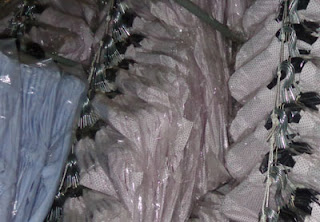Hazard Identification:
To ensure that no hazard identification and risk assessment
examples gets shipped with the finished products of the factory as this may
pose a threat to the Product or Customer/ Wearer of the product. To establish a
system/ policy to control/ prevent- Physical Contamination, Chemical Content, Allergens,
Packing Garments Defects, Labeling Issues leading to product legality and to maintain safety, quality and legality
of the product. The Management has formed a committee which consists of the
following members- Country Manager / Merchandising Manager, ACEO, GM Quality,
GM Production, chnical Manager
Procedure of hazard identification and risk assessment:
Product Legality:
- For each buyer, one Merchandising Manager has been assigned to look after legality before production commences.
- The Merchandising Manager has to ensure the legality for respective buyer.
Product Safety:
Auto is adhered to follow the SOP’s mentioned in its Quality Manual to ensure safety of the product by means of controlling Needle Policy, Sewing Button Attachment Policy, Sharp Tool Control Policy, etc.
Chemical hazard identification:
- Follow the Chemical Residue control Policy
- Follow the MSDS (Material Safety Data Sheet)
- Follow the general guidelines of Chemical Handling
- Follow the test reports done by third party.
- Any specific requirement of customer
For Chemical Hazard Identification Issues: The Management
has formed a committee which consists of the following members:
- Country Manager / Merchandising Manager
- ACEO
- GM Quality
- GM Production
- GM Washing
- LAB In-charge
Roles and Responsibilities: It is a responsibility of
Country Manager / Merchandising Manager to inform concern department about the buyer complaints. ACEO will set for a meeting with the above persons to
discuss and plan how to take action on a particular complain. GM Quality, GM Production, Technical Manager, GM Washing
will act as team leaders for each concern factories. They will further pass the message to
lower levels. They will also investigate the subject and forward details to
committee for further action and prevention plan. Investigation format is to be
duly filled and filed.
Hazard Identification of Chemical Procedures: Investigation
report will be carried out by the committee to identify the cause of a
particular complain.
 |
| Hazard Identification of Chemical Procedures |
Below procedure being followed by factory:
- Complain: Merchandising Head will state the complain of the buyer
- Investigation: Committee will perform thorough investigation
- Corrective Action Plan
- Prevention
- Follow-up by the complainant: Merchandising Head will follow-up on the result of the investigation to further update buyer.
In case of quality issues:
- Committee will review the previous audit report done by the QA Team
- Technical department will be asked to make comments.
- There will be a review to check if Merchandising department has made any comments
- with regards to the same issue.
- If it is fabric related, lab-incharge will be asked and all the related reports will be checked
- and reviewed like lab reports, fabric inspection reports.
In case of hazard / chemical issues:
- Advertisement will be arranged to ensure the awareness to costumers about the issue.
- They will request for the call back for bought garments to ensure no more additional complaints.
- Washing Managers will be requested to give comments / findings during production.
- Purchasing department / compliance department has all details about chemical histories and compositions which will be reviewed.
- There will be verification of a particular complains depending on chemical and trace down the suppliers where / when / how the items were bought.
Corrective Action Plan: For Quality Issue:
- To carry out daily / weekly / monthly periodical check.
- To follow-up constantly with concern the buyer requirements are met accordingly.
- Team is formed consists of Merchandiser and Production People to meet everyday 11am to attend Sewing Review and Finishing Review to ensure that good quality garments are sewn and garments are packed properly. These garments are randomly picked-up from production.
Prevention: For Hazard / Chemical Issue:
- All hazardous identification chemicals must be identified by product and by chemical name.
- Awareness of all hazardous chemicals and their bad effects (if misuse) also must be explained accordingly.
- Un-qualified / Un-experienced person should not be engaged on issuing, mixing, using on garments.
Standard Operating Procedure for Waste Handling and Disposal
There is huge wastes generated everyday from various section of the factory.Thus waste disposal policy becomes an integral part of environmental management system. Auto Fashions Ltd is very conscious to the fact. It is the responsibility of everyone within the factory to ensure that all work areas to keep in a neat & clean condition so that all work areas are kept as far as reasonably, practicable, & hazard free.
Cleanliness: All work area to be kept neat, tidy, clean by the company Cleaner works as per direction by the cleaning supervisor. Supervisor always keep eyes on cleanliness.
Type of waste: There are various types of waste-
- Air, liquid, solid waste
- Medical waste.
- Fabric/ Cut piece waste
- Others.
Segregation: Waste will segregated as per type of waste in areas of waste disposal.
Areas of waste: Waste to be deposited in proper place away from the factory building & will be disposed off in a ethical manner by designated agency.
Training program on waste disposal: The cleaner of the factory are given training for handling, storage, transportation of waste
Waste Disposal Record: A monthly record of waste disposal is maintained which also has details about type of waste.
List of Waste:
- Cutting jute
- Carton
- Poly
- Fabric
- Plstic
- Iron
- Fudge tube light etc.


0 Comments on "What is Hazard Identification and Risk Assessment Examples"